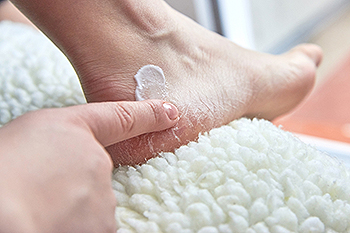Port Neches, TX (409) 727-1122
August 2022
Sever's Disease Affects Children and Young Teenagers

A common condition that can affect children and young teenagers who actively participate in sporting activities is known as Sever’s disease. This is an ailment that affects the heels, and can develop as a result of a heel growth spurt. The heel pain is caused by tight calf muscles or Achilles tendon, and the pain may increase when their chosen activities are pursued. You may notice your child is limping, walking on their toes, or experiencing swelling surrounding the heel. These symptoms may be indicative of Sever’s disease. It is beneficial to wear shoes that fit correctly, and this may help the affected foot to feel better. Effective treatment starts with stopping the activity that caused the condition. It is also important to elevate the foot as often as possible. The average recovery time for Sever’s disease is approximately 2-3 months. If your child has these symptoms, it is advised that you consult with a podiatrist who can effectively diagnose and offer treatment solutions.
Sever's disease often occurs in children and teens. If your child is experiencing foot or ankle pain, see Pete O’Donald, DPM from Texas. Our doctor can treat your child’s foot and ankle needs.
Sever’s Disease
Sever’s disease is also known as calcaneal apophysitis, which is a medical condition that causes heel pain I none or both feet. The disease is known to affect children between the ages of 8 and 14.
Sever’s disease occurs when part of the child’s heel known as the growth plate (calcaneal epiphysis) is attached to the Achilles tendon. This area can suffer injury when the muscles and tendons of the growing foot do not keep pace with bone growth. Therefore, the constant pain which one experiences at the back of the heel will make the child unable to put any weight on the heel. The child is then forced to walk on their toes.
Symptoms
Acute pain – Pain associated with Sever’s disease is usually felt in the heel when the child engages in physical activity such as walking, jumping and or running.
Highly active – Children who are very active are among the most susceptible in experiencing Sever’s disease, because of the stress and tension placed on their feet.
If you have any questions, please feel free to contact our office located in Nederland, TX . We offer the newest diagnostic and treatment technologies for all your foot and ankle injuries.
What Does a Podiatrist Treat?

A podiatrist is a specialized doctor whose main concern is the health of your ankles, feet and toes. Podiatrists can help improve mobility, relieve pain, and treat infections. They often play a role in treating chronic conditions, such as diabetes, which can adversely affect the feet. A podiatrist can offer advice on proper foot care and selecting footwear that fosters healthy feet and ankles. They also can create custom orthotic shoe inserts that work specifically to counteract any foot, gait, or other abnormalities you may have. Among the many conditions that a podiatrist can treat are ingrown toenails, corns and calluses, flat feet, bunions, plantar warts, and heel pain. In addition, podiatrists conduct surgery, reset broken bones, prescribe medications, and order lab tests, X-rays, and imaging tests. Podiatrists attend special podiatry colleges for four years and work in hospitals for three more years. They also get advanced certifications to perform surgery on feet and ankles and acquire the title of Doctor of Podiatric Medicine, or DPM, after their name. For help with your ankle, foot or toe problems, please make an appointment with a podiatrist.
If you are experiencing pain in the feet or ankles, don’t join the stubborn majority refusing treatment. Feel free to contact Pete O’Donald, DPM from Texas. Our doctor can provide the care you need to keep you pain-free and on your feet.
What Is a Podiatrist?
Someone would seek the care of a podiatrist if they have suffered a foot injury or have common foot ailments such as heal spurs, bunions, arch problems, deformities, ingrown toenails, corns, foot and ankle problems, etc.
Podiatric Treatment
A podiatrist will treat the problematic areas of the feet, ankle or lower leg by prescribing the following:
- Physical therapy
- Drugs
- Orthotic inserts or soles
- Surgery on lower extremity fractures
A common podiatric procedure a podiatrist will use is a scanner or force plate which will allow the podiatrist to know the designs of orthotics. Patients are then told to follow a series of tasks to complete the treatment. The computer will scan the foot a see which areas show weight distribution and pressure points. The podiatrist will read the analysis and then determine which treatment plans are available.
If you have any questions please feel free to contact our office located in Nederland, TX . We offer the newest diagnostic and treatment technologies for all your foot and ankle needs.
Plantar Fasciitis Is a Common Type of Heel Pain

Because heel pain can be caused by several conditions, it is important to have it diagnosed correctly and treated properly. The most common form of heel pain is plantar fasciitis. This is an inflammatory condition of the plantar fascia, which is the long rubber band-like connective tissue that connects the front of the heel bone with the toes. The plantar fascia is on the bottom of the foot. It undergoes a great deal of stress and pressure while doing its duty of helping to form the arch, aiding in the propulsive phase of the walking cycle, and acting like a shock absorber of sorts. Excessive wear and tear and stretching of the plantar fasciitis can irritate it, inflame it, and even create micro-tears where it inserts at the heel bone. This is known as plantar fasciitis, a very painful form of heel pain. Plantar fasciitis can be brought on by certain sporting activities like running, being obese, standing for prolonged periods, and more. If you have heel pain that is at its worst in the morning when you take your first steps of the day, or after periods of rest, you may have plantar fasciitis. Consult with a podiatrist to have your heel pain diagnosed and treated.
Plantar fasciitis is a common foot condition that is often caused by a strain injury. If you are experiencing heel pain or symptoms of plantar fasciitis, contact Pete O’Donald, DPM from Texas. Our doctor can provide the care you need to keep you pain-free and on your feet.
What Is Plantar Fasciitis?
Plantar fasciitis is one of the most common causes of heel pain. The plantar fascia is a ligament that connects your heel to the front of your foot. When this ligament becomes inflamed, plantar fasciitis is the result. If you have plantar fasciitis you will have a stabbing pain that usually occurs with your first steps in the morning. As the day progresses and you walk around more, this pain will start to disappear, but it will return after long periods of standing or sitting.
What Causes Plantar Fasciitis?
- Excessive running
- Having high arches in your feet
- Other foot issues such as flat feet
- Pregnancy (due to the sudden weight gain)
- Being on your feet very often
There are some risk factors that may make you more likely to develop plantar fasciitis compared to others. The condition most commonly affects adults between the ages of 40 and 60. It also tends to affect people who are obese because the extra pounds result in extra stress being placed on the plantar fascia.
Prevention
- Take good care of your feet – Wear shoes that have good arch support and heel cushioning.
- Maintain a healthy weight
- If you are a runner, alternate running with other sports that won’t cause heel pain
There are a variety of treatment options available for plantar fasciitis along with the pain that accompanies it. Additionally, physical therapy is a very important component in the treatment process. It is important that you meet with your podiatrist to determine which treatment option is best for you.
If you have any questions, please feel free to contact our office located in Nederland, TX . We offer the newest diagnostic and treatment technologies for all your foot care needs.
Can I Prevent Cracked Heels From Developing?

The foot condition known as cracked heels can be unsightly and uncomfortable. They develop as a result of having dry skin on the heels and surrounding area and may indicate a normal sign of aging. They can also come from wearing shoes with open backs like flip flops, which are popular shoes to wear in the warmer months. Additionally, they can come from standing on hard surfaces for most of the day or possibly from existing medical conditions. These can include eczema, psoriasis, or a thyroid disorder. In severe cases, the cracks in the skin may develop into fissures, which are deeper cracks that can bleed. Relief may come from washing and drying the feet daily followed by applying a good moisturizer. The feet will feel better when shoes that are worn have closed backs as well as wearing quality socks. Lastly, many patients have found it helps to drink fresh water frequently. If you have cracked heels and would like to know how to find relief and prevent them, please speak with a podiatrist.
If the skin on your feet starts to crack, you may want to see a podiatrist to find treatment. If you have any concerns, contact Pete O’Donald, DPM from Texas. Our doctor can provide the care you need to keep you pain-free and on your feet.
Cracked Heels
It is important to moisturize your cracked heels in order to prevent pain, bleeding, and infection. The reason cracked heels form is because the skin on the foot is too dry to support the immense pressure placed on them. When the foot expands, the dry skin on the foot begins to split.
Ways to Help Heal Them
- Invest in a good foot cream
- Try Using Petroleum Jelly
- Ease up on Soaps
- Drink Plenty of Water
Ways to Prevent Cracked Heels
- Moisturize After Showering
- Skip a Shower
- Keep Shower Water Lukewarm
- Don’t Scrub Your Feet
If you are unsure how to proceed in treating cracked heels, seek guidance from a podiatrist. Your doctor will help you with any questions or information you may need.
If you have any questions, please feel free to contact our office located in Nederland, TX . We offer the newest diagnostic and treatment technologies for all your foot care needs.
Plantar Warts Can Be Treated!
What Is Kohler’s Disease?

Taking care of your feet is an integral component of maintaining your overall well-being. However, there are a number of rare foot conditions that can make it especially difficult for you to care for your feet. Although these conditions are rare, it can be helpful to learn more about them in case you ever must identify them in yourself or a loved one. Kohler’s disease is one kind of rare foot condition. This affliction is most common in young boys between the ages of 2 and 10. It occurs primarily when the navicular bone, located between the ankle and heel, does not grow properly. Specifically, the navicular bone can become essentially flattened, which can lead to swelling and pain, sometimes making it difficult to walk. Typically, a child with Kohler’s disease will only exhibit this condition in one foot, as opposed to both feet. To properly diagnose Kohler’s disease, a medical professional might have to perform an X-ray. Treating Kohler’s disease might involve using a cast and, if the child is old enough, giving the child crutches to walk on while the condition subsides. If you think that your child might have Kohler’s disease, it may be a good time to contact a podiatrist.
Some foot conditions may require additional professional care. If you have any concerns, contact Pete O’Donald, DPM of Texas. Our doctor can provide the care you need to keep you pain-free and on your feet.
Rare Foot Conditions
The majority of foot conditions are common and can be treated by a podiatrist. Standard diagnostic procedures are generally used to identify specific conditions and treatment can be rendered. A podiatrist also treats rare foot conditions which can be difficult to diagnose and may need extra attention and care.
There are many rare foot conditions that can affect children. Some of these can include:
- Freiberg’s disease
- Kohler’s disease
- Maffucci syndrome
Freiberg’s disease - This can be seen as a deterioration and flattening of a metatarsal bone that exists in the ball of the foot. It typically affects pre-teen and teenage girls, but can affect anyone at any age. Symptoms that can accompany this can be swelling, stiffness, and the patient may limp.
Kohler’s disease - This often targets the bone in the arch of the foot and affects younger boys. It can lead to an interruption of the blood supply which ultimately can lead to bone deterioration. The patient may limp or experience tenderness, swelling, and redness.
Maffucci syndrome - This affects the long bones in a child’s foot leading to the development of abnormal bone lesions. They are benign growths and typically develop in early childhood and the bones may be susceptible to breaking.
A podiatrist can properly diagnose and treat all types of rare foot conditions. If your child is affected by any of these symptoms or conditions, please don’t hesitate to call our office so the correct treatment method can begin.
If you have any questions please feel free to contact our office located in Nederland, TX . We offer the newest diagnostic tools and technology to treat your foot and ankle needs.





